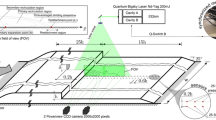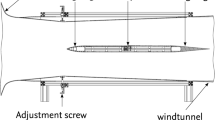Abstract
In this study, we investigate the effect of the spanwise width on the mixing layer behind a rearward-facing step. Results for aspect ratios (tunnel width/step height) of 10 and 4 and Reynolds numbers of 11,000 and 5,000 are presented. A frequency shifted, single component LDV system was used to obtain mean streamwise velocity profiles, turbulence intensity profiles, and normal velocity spectra at four streamwise and three spanwise positions for each test case. The mean velocity and turbulence intensity profiles are constant across the width of the test section for either of the Reynolds numbers considered, but there are significant differences among the cases studied. At a distance greater than three step heights down-stream of the step, the peak turbulence intensity is greater for higher aspect ratio and is relatively insensitive to Reynolds number. The peak frequency is lower and the spectrum is narrower for a higher aspect ratio in the region near the step.
Similar content being viewed by others
References
Abbot, D. E.; Kline, S. J. 1962: Experimental investigation of subsonic flow over single and double backward facing steps. J. Basic Eng. 84, 317–325
Ashurst, W. T. 1979: Numerical simulation of turbulent mixing layers via vortex dynamics. In: Turbulent shear flows 1. (eds. Durst, F.; Launder, B. E.; Schmidt, F. W.; Whitelaw, J. H.). pp. 402–413. Berlin, Heidelberg, New York: Springer
Berbee, J. G. 1987; Aspect ratio and Reynolds number effects on the flow behind a rearward-facing step. MS thesis. Madison: University of Wisconsin
Bradshaw, P. 1966: The effect of initial conditions on the development of a free shear layer. J. Fluid Mech. 26, 255–236
Brederode, V. de; Bradshaw, P. 1972: Three-dimensional flow in nominally two-dimensional separation bubbles I. Flow behind a rearward-facing step. Imparial College of Science and Technology, Aero report 72–19
Browand, F. K.; Latigo, B. O. 1979: Growth of the two-dimensional layer from a turbulent and non-turbulent boundary layer. Phys. Fluids 22, 1011–1019
Browand, F. K.; Weidman, P. D. 1976: Large scales in the developing mixing layer. J. Fluid Mech. 76, 127–144
Brown, G. L.; Roshko, A. 1974: On density effects and large structure in turbulent mixing layers. J. Fluid Mech. 64, 775–816
Castro, I. P. 1979: Numerical difficulties in the calculation of complex turbulent flows. In:Turbulent shear flows 1. (eds. Durst, F.; Launder, B. E.; Schmidt, F. W.; Whitelaw, J. H.), pp. 220–236. Berlin, Heidelberg, New York: Springer
Dahm, W. J. A.; Dimotakis, P. E. 1985: Measurements of entrainment and mixing in turbulent jets. AIAA Paper 85–0056
Dimotakis, P. E.; Brown, G. L. 1976: The mixing layer at high Reynolds number: large-structure dynamics and entrainment. J. Fluid Mech. 78, 535–560
Eaton, J. K.; Johnston, J. P. 1981a: Low frequency unsteadiness of a reattaching turbulent shear layer. In: Turbulent shear flows 3. (eds. Bradbury, L. J. S.; Durst, F.; Launder, B. E.; Schmidt, F. W.; Whitelaw, J. H.), pp. 162–170. Berlin, Heidelberg, New York: Springer
Eaton, J. K.; Johnston, J. P. 1981 b: A review of research on subsonic turbulent flow reattachment. AIAA J. 19, 1093–1100
Freymuth, P. 1966: On transition in a separated laminar boundary layer. J. Fluid Mech. 25, 683–704
Ganji, A. R.; Sawyer, R. F. 1980: An experimental study of the flow field and pollutant formation in a two-dimensional, premixed, turbulent flame. 17th Aerospace sciences meeting. AIAA report 79–0017
Ghoniem, A. F.; Chorin, A. J.; Oppenheim, A. K. 1982: Numerical modelling of turbulent flow in a combustion tunnel. Philos. Trans. R.S. London, Ser. A 304, 303–325
Gosman, A. D.; Khalil, E. E.; Whitelaw, J. H. 1979: The calculation of two-dimensional turbulent recirculation flows. In: Turbulent shear flows 1. (eds. Durst, F.; Launder, B. E.; Schmidt, F. W.; Whitelaw, J. H.), pp. 237–255. Berlin, Heidelberg, New York: Springer
Grinstein, F. F.; Oran, E. S. 1988: Entrainment and mixing enhancement in spatially evolving shear flow. Presented at the 25th JANAF combustion meeting. Huntsville
Kibens, V. 1980: Discrete noise spectrum generated by an acoustically excited jet. AIAA J. 18, 434–441
Konrad, J. H. 1976: An experimental investigation of mixing in two-dimensional turbulent shear flows with applications to diffusion-limited chemical reactions. Project SQUID, CIT-8-PU. Pasadena: California Institute of Technology
Pitz, R. W. 1981: An experimental study of combustion: the turbulent structure of a reacting shear layer formed at a rearward-facing step. NASA contractor report 165427
Roshko, A. 1981: The plane mixing layer: flow visualization results and three-dimensional effects. In: The role of coherent structures in modelling turbulence and mixing. (ed. Jimenez, J.). pp. 208–217. Berlin, Heidelberg, New York: Springer. (Lecture notes in physics, vol. 136)
Roos, F. W.; Kegelman, J. T. 1986: Influence of excitation on coherent structures in reattaching turbulent shear layers. AIAA report MDRL 86-4
Winant, C. D.; Browand, F. K. 1974: Vortex pairing: the mechanism of turbulent mixing layer growth at moderate Reynolds number. J. Fluid Mech. 63, 237–255
Wgnanski, I.; Oster, D.; Fielder, H.; Dziomba, B. 1979: On the preseverance of a quasi-two-dimensional eddy-structure in a turbulent mixing layer. J. Fluid Mech. 93, 325–335
Author information
Authors and Affiliations
Rights and permissions
About this article
Cite this article
Berbee, J.G., Ellzey, J.L. The effect of aspect ratio on the flow over a rearward-facing step. Experiments in Fluids 7, 447–452 (1989). https://doi.org/10.1007/BF00187062
Received:
Issue Date:
DOI: https://doi.org/10.1007/BF00187062




